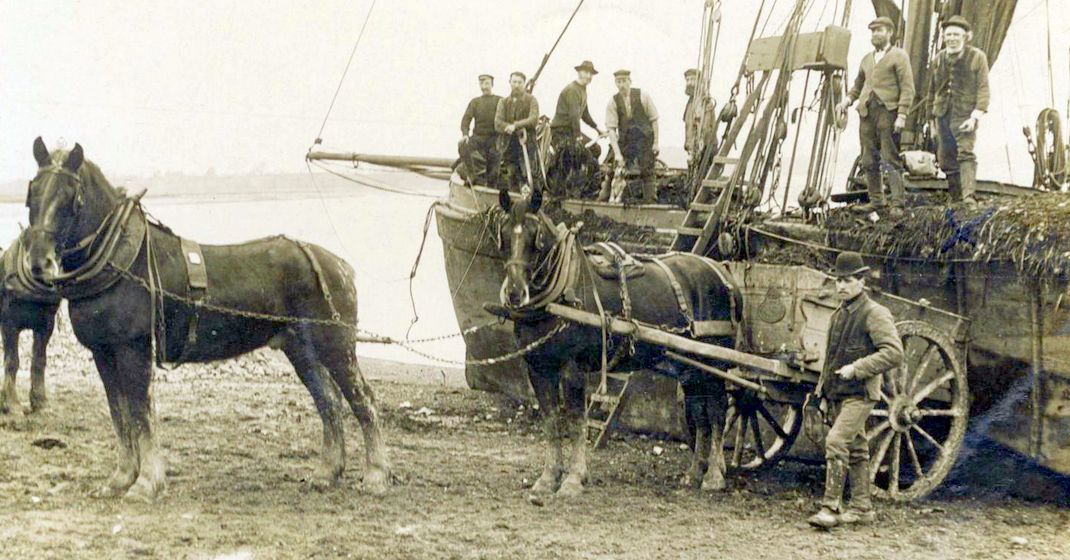Towards the end of the nineteenth century, London was the largest city in the world and road transport was powered by horse: fifty-thousand horses were required just to keep Victorian London’s public transport running, another ten thousand horses for hansom cabs, and countless more to substitute for white vans made around 300,000 horses producing, say, a thousand tons of excrement per day. By 1894 this gave rise to ‘The Great Horse Manure Crisis1The Great Horse Manure Crisis of 1894 (historic-uk.com).
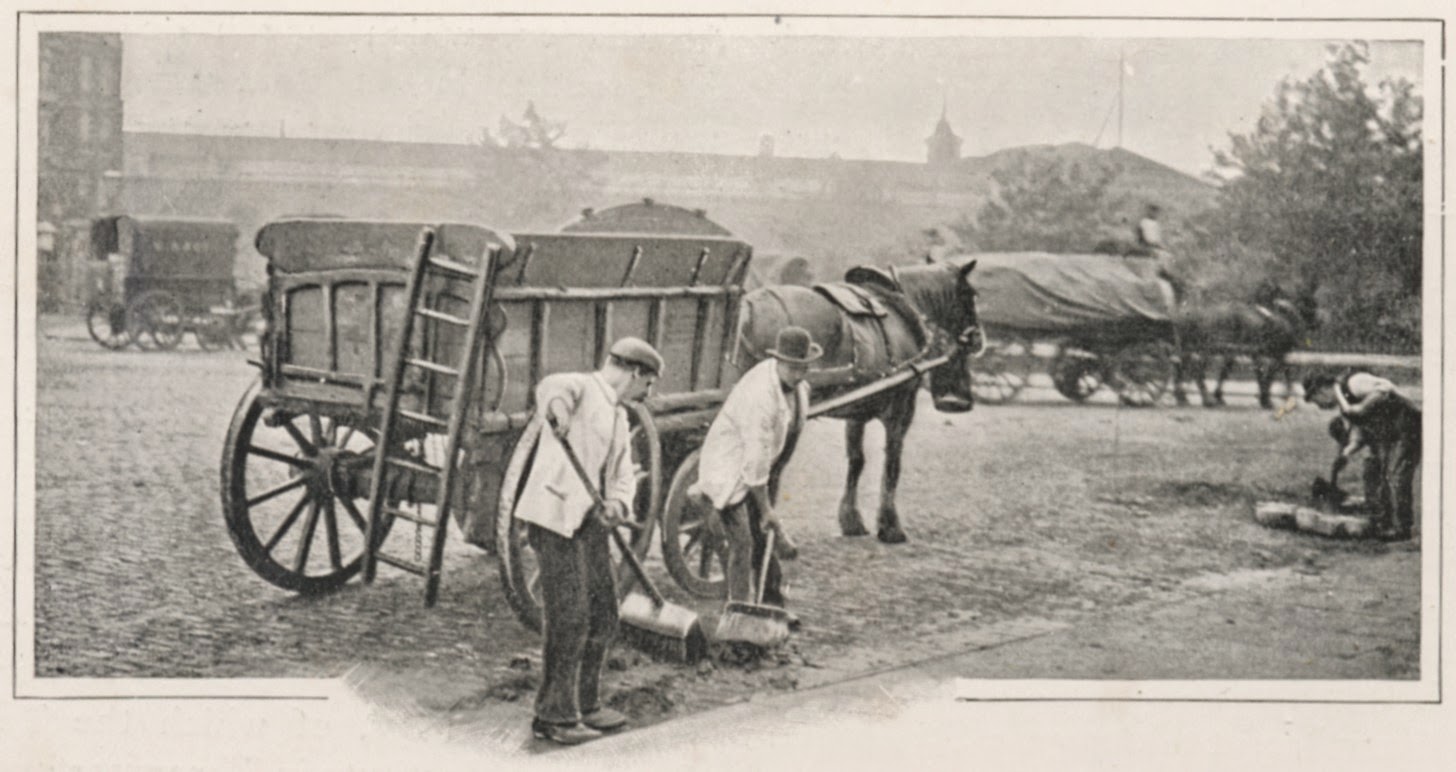

These horses also needed to be fed, as did the ten thousand cows in the seven hundred ‘Milking Barns’ spread around the city: yet another source of excrement2Milking Barns – Atkins, P. J. (1977). London’s Intra-Urban Milk Supply, circa 1790-1914. Transactions of the Institute of British Geographers, 2(3), 383. doi:10.2307/621838 .
This situation, of course, had developed over the decades but given the increasing need to dispose of this material the importance of the ‘Muck and Straw’ trade becomes apparent. Such a volume of ‘product’ would need hundreds of barges per day unless there was some other disposal method. The economics would have been interesting; who paid whom?
Neither living aboard with nor loading and unloading can have been a pleasant occupation, as the photograph shows.
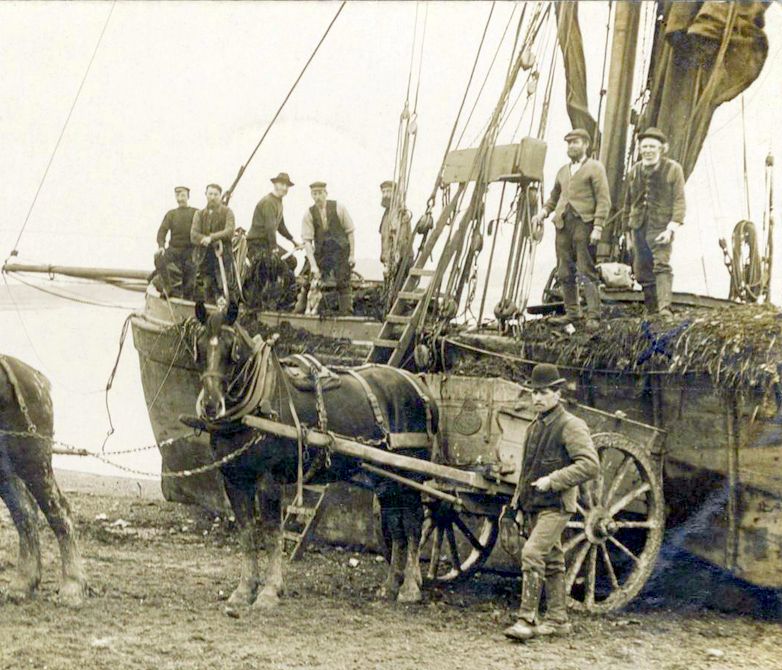
This trade would have been the most enduring and malodorous. It ran from at least the 1830s to the early 1900s by which time motor transport had become dominant (causing a different problem). The main operators were the Orwell and Stour based Hastes, Wrinches and Whitmores as well as the Parkers of Bradwell. The London specialist was William Dodd, the “Golden Dustman”, who also started barge racing3Henry Dodd died 27th April 1881 – Topsail 92.
The street muck, known as ‘London Violets’, was spread on the fields. Supposedly all windows in the area had to be closed when deliveries were made. Lime for the fields was also brought from the Medway4Lime for farms – Willmott, F.G. (n.d.) Cement, Mud and Muddies, a history of APCM barges.. If shipped as quicklime, it burned if it got wet, so an auger was carried to scuttle the barge in case of fire: a desperate scenario. Did this ever happen?
Hay fodder and straw bedding for the London horses and sometimes mangolds or mangelwurzels to feed the cows in the milking barns was an outbound cargo. Perhaps an extra tide was taken to rinse out the hold5Barges had bungs which could be removed to let water in and out, .The denser mangelwurzels and bales of hay6Bales of hay, about thirty-five bales per ton were stored in the hold and the straw7Straw was about forty five per bales per ton was stacked on deck. There were many quays and landing places to conduct this trade on the East Coast rivers.
Some ‘Stack’ barges such as Rachel & Julia in the photograph were purpose built for this traffic with a wider deck, special irons to hold the stack in place and a sail that could be adjusted to fit over the stack.
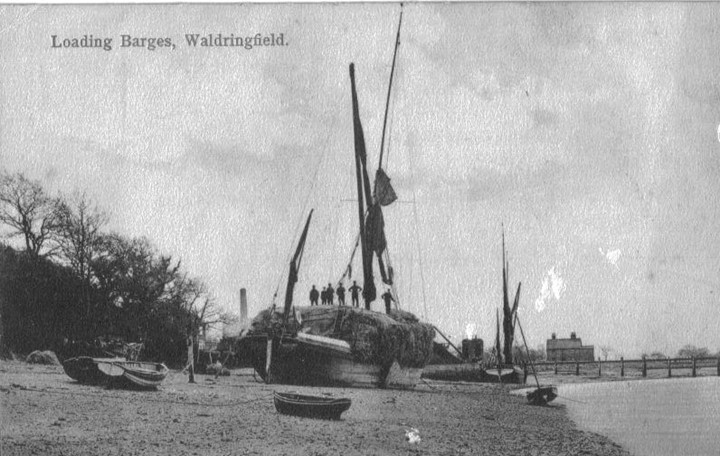
Note the mooring post on the beach, there was a series of these which would have assisted barges to position themselves so that they could settle in the desired area of the beach. These disappeared over the course of the twentieth century.
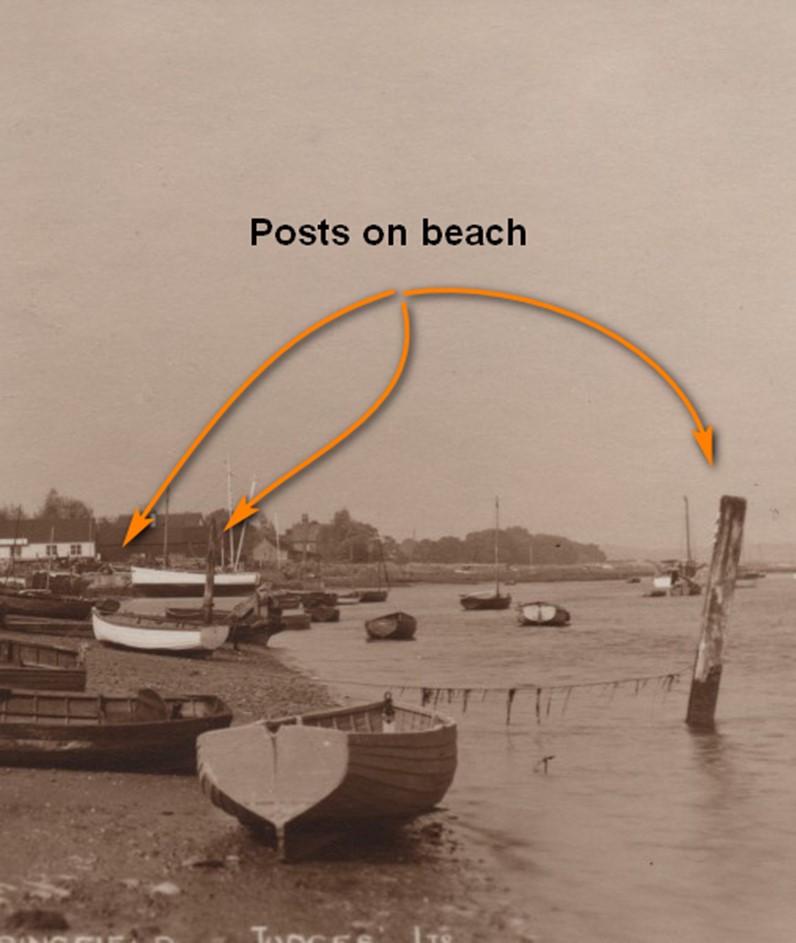
A Stack Barge must have been challenging to control with the skipper helming by instructions from the mate standing on the 12-foot (4m) high stack of hay. Some of the other barges in this trade likely to have called at Waldringfield include Bluebell (see later) and Victoria.
A London return trip took perhaps a fortnight or so, living on board in a cabin at the stern8A London return trip – Smith, R.W. (n.d.) Thames Barge in Suffolk. – A Passage from Ipswich to London in 1940s – Tom Polley. In 2011 Dawn re-created a stack barge trip to St Katherine Dock9SB Dawn – Stack Barge trip www.dawn1897.com(url now dead).
Similar arrangements existed at many points along the East Coast rivers, although Waldringfield, with its shingle beach, posts, all-tide access and pub, must have been a choice location.
Fate of the barges
Rachel & Julia, the stack barge, was converted into a lighter. Victoria became a house barge in 1930. Bluebell, by 1939, had been converted to the barge yacht Torchbearer and by 1942 had been requisitioned for the Royal Navy to serve alongside Jumbo at Harwich. Bluebell was eventually hulked in the 1950s at St Osyth10Photo of Bluebell remains on FaceBook Dave Brooks[/mfn.]
Barge Details
Name: Rachel and Julia, Official No.: 68392, Owner: 1893 George Vandervoord, Year built: 1873, Built at: Milton, Built by: Shrubsall, GRT: 53, Dimensions ft: ,
Name: Victoria, Official No.: , Owner: , Year built: 1868, Built at: , Built by: , GRT: 39, Dimensions ft: ,
Name: Bluebell, Official No.: 95304, Owner: Wrinch, Year built: 1888, Built at: Rochester, Built by: Curel, GRT: 45, Dimensions ft: ,
Notes
Thames Sailing Barges | Remains of the Stackie Barge Bluebell at St Osyth | Facebook
The North East Essex Times | Wrinches barge Bluebell at Shotley Hard 1938. | Facebook
Rural East Suffolk In Old Photographs | Bluebell Thames Sailing Barge, Erwarton | Facebook
Was this the same Bluebell? Good picture of Wreck Marker boat.
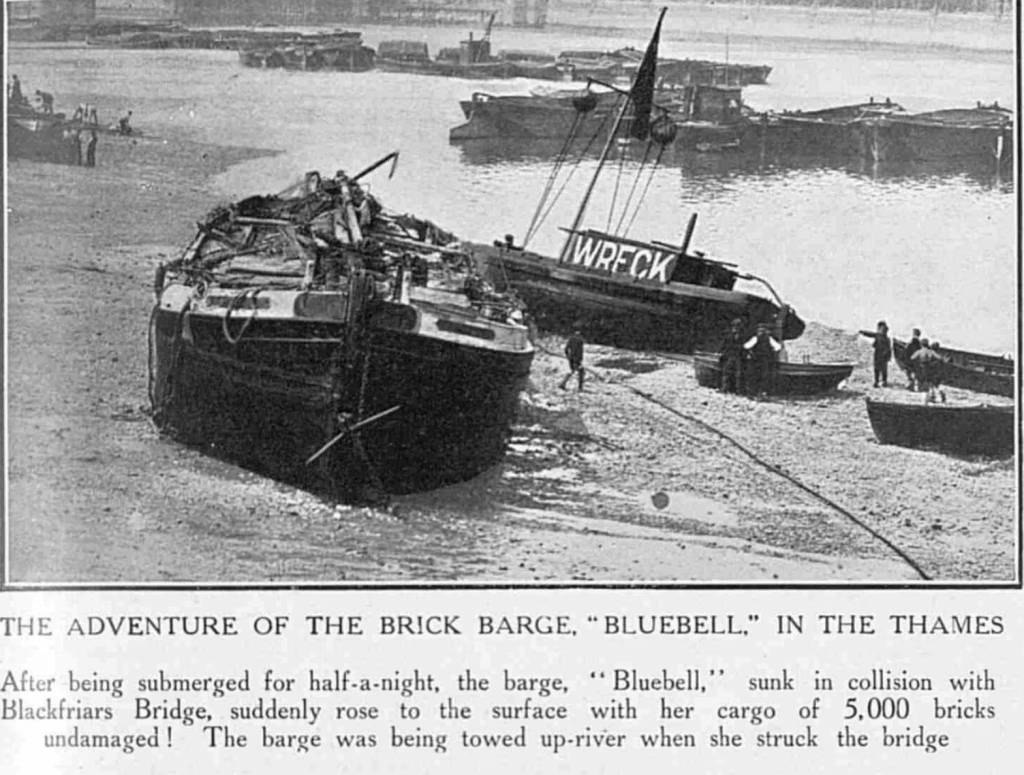
Questions
How many barges were involved? assuming 1,000 tons per day that makes about 120 barges per day. If it was a two-week round trip then 14 barges would be needed to operate constantly. This makes 14×120=1680 vessels assuming there are no hold-ups. So, very roughly there should be about 2,000 operating this trade at its peak. How does this compare to the known fleet?
Sources
Jackson, Lee. Dirty Old London: The Victorian Fight Against Filth. Reprint edition, Yale University Press, 2015.
‘Dirty Old London’: A History Of The Victorians’ Infamous Filth : NPR
Footnotes
- 1
- 2Milking Barns – Atkins, P. J. (1977). London’s Intra-Urban Milk Supply, circa 1790-1914. Transactions of the Institute of British Geographers, 2(3), 383. doi:10.2307/621838
- 3Henry Dodd died 27th April 1881 – Topsail 92
- 4Lime for farms – Willmott, F.G. (n.d.) Cement, Mud and Muddies, a history of APCM barges.
- 5Barges had bungs which could be removed to let water in and out,
- 6Bales of hay, about thirty-five bales per ton
- 7Straw was about forty five per bales per ton
- 8A London return trip – Smith, R.W. (n.d.) Thames Barge in Suffolk. – A Passage from Ipswich to London in 1940s – Tom Polley
- 9SB Dawn – Stack Barge trip www.dawn1897.com(url now dead)
- 10
Image Sources and Credits
Image Credits and Sources
- Waldringfield unloading muck barge: Courtesy Ron Green
- 1938-posts-on-the-beach: 1938 posts on the beach from postcard
- 1
- 2Milking Barns – Atkins, P. J. (1977). London’s Intra-Urban Milk Supply, circa 1790-1914. Transactions of the Institute of British Geographers, 2(3), 383. doi:10.2307/621838
- 3Henry Dodd died 27th April 1881 – Topsail 92
- 4Lime for farms – Willmott, F.G. (n.d.) Cement, Mud and Muddies, a history of APCM barges.
- 5Barges had bungs which could be removed to let water in and out,
- 6Bales of hay, about thirty-five bales per ton
- 7Straw was about forty five per bales per ton
- 8A London return trip – Smith, R.W. (n.d.) Thames Barge in Suffolk. – A Passage from Ipswich to London in 1940s – Tom Polley
- 9SB Dawn – Stack Barge trip www.dawn1897.com(url now dead)
- 10
Image Credits and Sources
- Waldringfield unloading muck barge: Courtesy Ron Green
- 1938-posts-on-the-beach: 1938 posts on the beach from postcard
